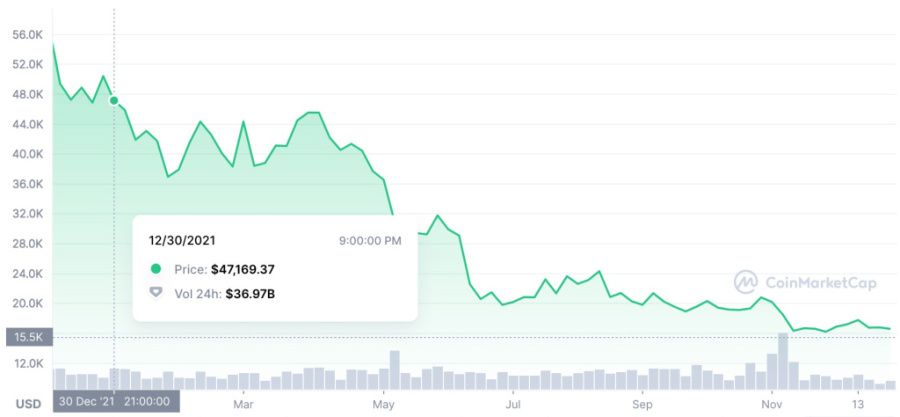Fraud, Bankruptcies, And Collapses: How 2022 Became A Terrible Year For Cryptocurrencies

2022 was a year that saw the massive collapse of high-profile companies and the crash of crypto prices. The year's events left many investors with fears and made it difficult for cryptocurrency market analysts to predict prices.
However, after the bullish rally in 2020 and 2021, the decline was to be expected. This was not the first time the crypto market experienced such events; so far, cryptocurrencies have experienced such unusual cycles three times. This is how 2022 became a year of crypto carnage.
Misperception of interest rates
Bitcoin price is currently more than 75% lower than it was a year ago (BTC price on December 30, 2021 - $47,169, according to CoinMarketCap data). A major contributing factor has been rising interest rates from central banks, which have put pressure on risk assets like cryptocurrencies and stocks this year.

In May, the cryptocurrency market began to see a massive drop in prices after the U.S. Federal Reserve raised interest rates by 50 basis points as part of an effort to fight inflation. This move caused the price of bitcoin to fall from the $36,300 mark from the $42,500 level.
On December 14, the Federal Reserve announced a 50 basis point rate hike, a move that brought crypto prices to their knees along with stocks. This year, the central bank has already raised interest rates four times by 75 basis points to curb rising inflation, which is currently at a 40-year high in the U.S.
As a result, Bitcoin has lost almost 75% of its value since reaching its all-time high of $64,979 last November on some exchanges, and so far over $2 trillion in value has been wiped out across the crypto market. At the time of writing, the bitcoin price was $16,548.40.
The shocks triggered by war between Russia and Ukraine are also causing global inflationary pressures and impacting global demand. Food and energy prices, for example, have risen more than 50% this year, and central banks have raised interest rates to fight inflation. The Fed indicated this month that it plans to continue its aggressive monetary policy in 2023.
Cryptocurrency market crashes
In the last seven months, the crypto market has lost $2 trillion, a spectacular collapse that has left the once fast-growing industry in trouble. In May, the collapse of the stablecoin TerraUSD and its sister token Luna hit several companies involved in both cryptocurrencies.
In June, cryptocurrency hedge fund Three Arrows Capital and crypto lending firm Celsius Network plunged into liquidation and filed for bankruptcy due to their exposure to TerraUSD. Many other crypto firms such as BlockFi, Voyager, Genesis Trading and others also suffered massive losses due to their investments in Three Arrows. In November, FTX's collapse triggered a far-reaching effect and continues to impact the entire industry.
The general crypto crash has led to massive layoffs at several crypto firms and exchanges, as well as the suspension of customer withdrawals and business operations, leaving customers out in the cold.
What's the progress?
While collapses are nothing unusual in the cryptocurrency landscape, this year's market crash was frightening. This crypto disaster has left investors in limbo, and many have cut their losses and exited the space. However, more global regulations are being enacted to counter the threat, and crypto innovation continues regardless of the price drop. In recent years, Bitcoin has made its way into financial markets worldwide and is now held by corporations, institutions, sovereigns, and millions of retail investors. And DeFi adoption continues to grow.
Coin expert
Price
Price
Coin expert
Price

(0 comments)